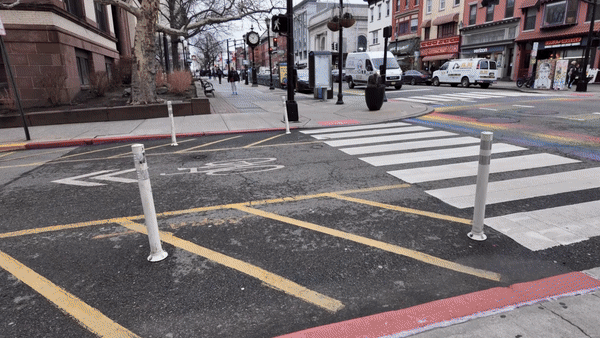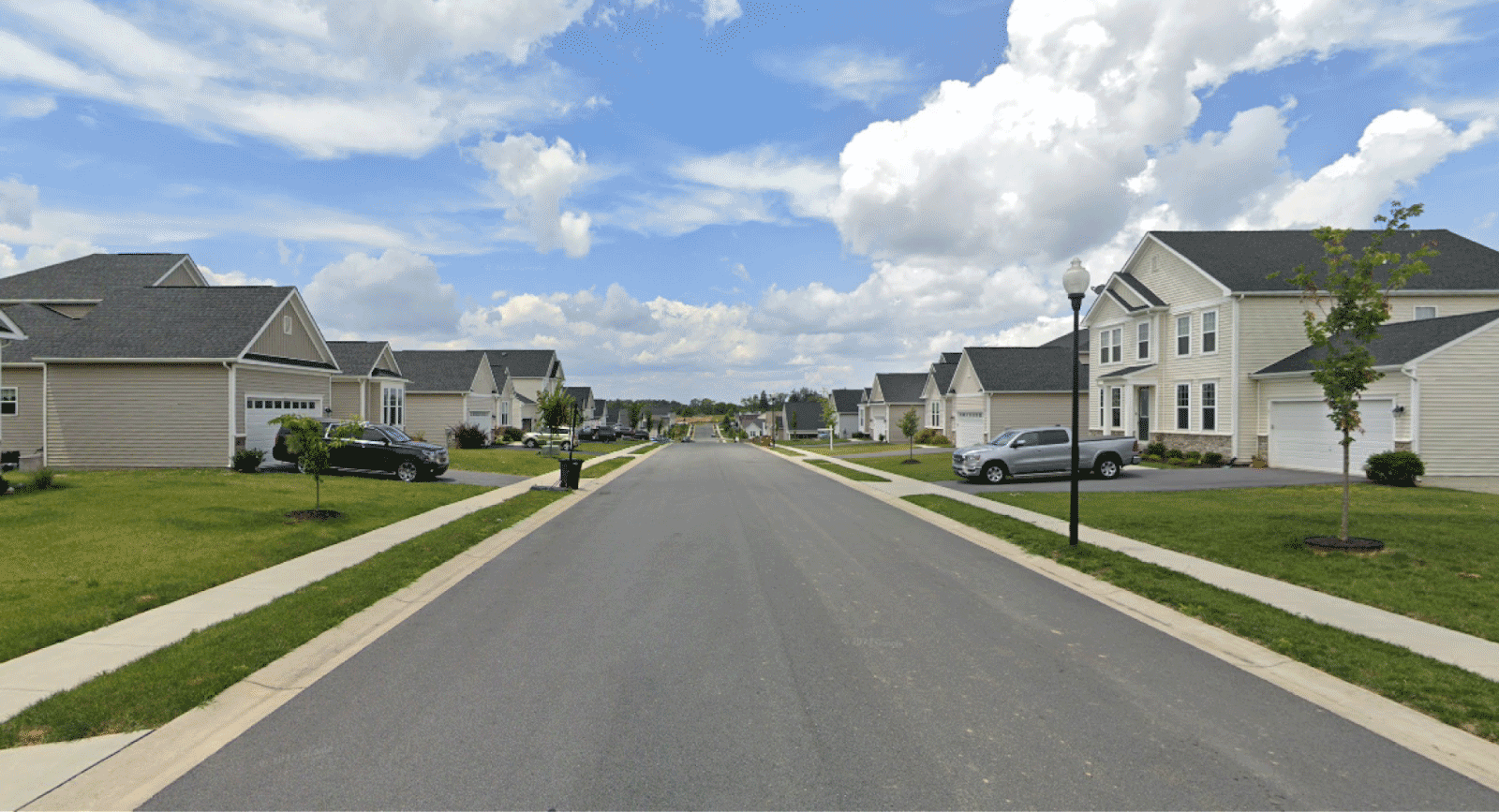A Walk in Hoboken: What Makes It Different?
Longtime Strong Towns contributor Andrew Price gives a tour of the famously safe streets of Hoboken, NJ. (To see more of the footage we got, check out the companion video to this article, “Why Is It So Hard To Cross The Street? (& What You Can Do To Help)”!)
It’s Monday, January 29, and I’m heading to Hoboken, New Jersey, to experience first hand everything I’ve read about the city.
I was hoping to make this trip during a decidedly warmer season, both for my own sake and for the sake of documenting a prettier, livelier city. I wanted to capture tree-lined streets in full bloom, parks buzzing with children, and the volume of people that only sunny days can guarantee.
Then again, today’s gray, icy, and windy conditions are actually appropriate if I’m interested in seeing just how successful Hoboken’s headline-grabbing interventions have been. Feeling safe crossing the street is a 24/7/365 expectation, not a privilege limited to the warmer months. Those months may showcase the fullest potential of, say, a pedestrian plaza or parklet, but if the sense of safety doesn’t translate to grayer days, rainier ones, or even nighttime, then arguably, those interventions aren’t enough.
What a Little Bit of Visibility Can Do
My local expert—and one of the founding members of Strong Towns—Andrew Price is waiting for me right outside the station. As I exit, I’m struck by how, despite being on the fringe of the city, adjacent to a rail yard, it feels as though I’ve landed in the heart of Hoboken. There are apartment buildings, storefronts, and sidewalk cafes within a minute’s walk. For passengers going deeper into New Jersey, a bus hub right outside the station makes the transfer seamless. It’s far from fancy, but I appreciated how there’s no need for prospective bus passengers to cross the street.
“We’re right in the heart of the city, would you say?” I asked Andrew.
“The bottom right corner of it,” he corrects me, and we chuckle.
Andrew led the way and already at the first intersection we encountered, directly outside of the PATH station I exited, Hoboken’s commitments were on display. On our corner, the sidewalk was extended near the intersection in what’s known as a concrete bump-out. On the opposite side, two plastic delineators, or “flexposts” as they’re often called, signaled where not to park.
At the next intersection, I saw the same. The one after that disguised traffic calming in a rain garden, tackling Hoboken’s drainage and Vision Zero with a few pounds of soil and an ounce of foresight. Some were colorful, ostensibly the fruit of a collaboration between the city and local artists. Others—the majority, in fact—were comparatively drab, but easy to replicate: painted stripes and a plastic post.
Some of the examples of daylighting on my walk. Some of these were on the same intersection.
Generally speaking, what I was seeing at every intersection is known as “daylighting”: the practice of increasing visibility at intersections by removing on-street obstructions (like parking) that block sightlines.
“Stand at a corner, and you can see what is coming toward you, and drivers can see you too, and you don’t have to step out into the road and risk your life to do it,” journalist Christopher Robbins wrote in 2022 when he visited Hoboken to understand how it, at that point, managed not to have a single traffic death on its streets in four years. In that same period, neighboring New York City was witnessing an uptick in fatal crashes. While the city is exponentially larger than Hoboken, Robbins noted that even if cut up into Hoboken-sized chunks, New York’s shortcomings were apparent.
Daylighting made the difference in Hoboken, but Robbins pointed out that doing the same across the Hudson would be politically untenable, a non-starter. The backlash at removing four spots from each of New York City’s 39,000 intersections (156,000 spots according to his calculations) would be “more than enough to start several wars.”
“That’s the thing. It’s not technically a parking spot,” Ryan Sharp, Hoboken's transportation and parking director, explained. New Jersey law prohibits parking within 25 feet of a crosswalk and in fact, New York, Philadelphia, Boston, Richmond, and dozens of cities and states across the country have similar laws in their books. “If it’s not something that is currently being enforced, that’s incredible, low-hanging fruit that’s not being taken advantage of,” he added.
As we walked, I was impressed by the consistency. There was plenty of variation—no two intersections looked alike—but with one or two exceptions, every intersection had something. I couldn’t help but contrast it with my own city, where examples of daylighting are pretty, but isolated. How helpful is a creative paint job on one intersection when there’s nothing like it for 10 blocks in either direction?
As Andrew and I snake through the city, I notice myself backtracking and double-taking to confirm that, indeed, the intersection we passed was daylit. With maybe one exception, they all were, at least on our route, but these interventions were so simple and unobtrusive that they stopped standing out early into our walk. I was captivated by the unostentatious power of the modest paint stripe and plastic post.
“How did these come about?” I asked Andrew. “Did you wake up one day and all of Hoboken’s intersections were daylit?”
In his experience, the city took the opportunity to daylight when it came time to repave or repair the street for entirely unrelated reasons. This was a way for the city to exercise the idea of “leaving things better than you found them,” but it also turned out to be efficient. In so many cities, municipal departments seldom coordinate their efforts with one another. One week, the gas company will tear up the street to repair underground pipes. A few days later, the water department might dig the same hole only for Public Works to begin their own project barely a week later.
Hoboken’s streets also underwent daylighting thanks to neighborly requests. In fact, in 2022, daylighting intersections was the most popular request the city fielded. In my own city, the most popular intervention is the speed bump, which for years was the only street calming device an individual could request from the city. To this day, it’s the recommended intervention but only a handful of corridors qualify. It’s worth noting I didn’t encounter any speed bumps on my walk in Hoboken.
Hoboken’s Vision Zero is one of the most ambitious pedestrian safety plans in the country, seeking to eliminate all serious traffic related injuries - not just fatalities - by 2030. With 7 years having gone by without a traffic related death, here is a snapshot of a few of our… pic.twitter.com/ji3uDRQbcP
— Ravinder S. Bhalla (@RaviBhalla) January 30, 2024
Less Is More
Maybe because most of the trees were dull and leafless, as is their right in the winter, or because my attention was concentrated on our conversation, I failed to take inventory of how green the city was until Andrew and I ducked into a café to defrost. From within the café, I appreciated the trees lining this central commercial thoroughfare. When we left and retraced some of our route, I counted about a dozen trees per block. Some loomed large, likely older than I am. Others were recently planted saplings. I could only imagine how nice this city looks in the spring.
Trees are a longtime favorite “design feature” for Strong Towns advocates. Among the good they do, trees, especially when they line streets, optically narrow the road, encouraging slower driving.
Furthermore, those tree-lined streets that were already narrower by design, some by consequence of being a hundred years old, others through present-day choices. Even in newer developments unconstrained by legacy infrastructure, roads remained at approximately nine feet while sidewalks were noticeably wider.
On one of the city’s widest roads, 11th Street, the addition of street parking on one side, a bike lane on the other, and a sizeable tree-filled median bisecting the road made what could’ve easily been a stroad into a picturesque mall. In fact, Andrew told me the median doubles as a community garden.
Several tree-lined streets on my walk, including the 11th Street median.
All of these visual cues work in concert with the city speed limit of 20, born out of a “20 is plenty” campaign. Without a speedometer in hand, I can’t confirm that every car was operating at 20 or below, but visibly, every car was going slow enough to react to the mess of kids spilling onto the streets when schools began emptying around 4 p.m.
How To Step Over the Red Tape
“This is 4th and Garden, and technically Garden is a county road,” Andrew pointed out. Being a county road means Hoboken has limited jurisdiction over its design, a complication likely familiar to advocates all over the country.
A school stands on one side of Garden Street and a playground beside some basketball courts, presumably where recess is conducted, on the other. Andrew pointed out this intersection because despite being a county road, we could appreciate an example of daylighting. In fact, each corner looked a little different: on one, a bike rack was installed, on the other, a curb extension doubled as a rain garden, and down a block another bump-out and across it, some paint and posts.
He conceded that daylighting this block involved pushing through more red tape than usual, but the success of daylighting elsewhere mobilized the community to fight for a proven intervention. Having a trailblazing mayor at the helm was a huge help.
Can Your Town Be Like Hoboken?
As I walked through the city, I asked myself a question I’d seen countless times: “Is this replicable where I live?”
Hoboken isn’t a master-planned, monochromatic paradise. Four-floor Brownstones mingle with 200-foot towers and NJ Transit coach buses destined for other corners of the state share the road with personal vehicles and delivery trucks. The city’s traffic isn’t characterized by smaller vehicles, either. In fact, I saw many a Ford pick-up with nothing in the truck bed, larger SUVs occupied by only the driver, delivery vans, and waste management vehicles. Those vehicles may have looked especially out of place on narrow, persistently daylit streets, but all of this is to say that unlike some “urbanist paradises” (Culdesac Tempe comes to mind) everything in Hoboken was familiar. Its residents aren’t anomalies and neither are its drivers uniquely vigilant.
Hoboken didn’t become one of the best and largest case studies of how impactful design can be on human behavior because its residents value walkability or safety any more than people in New York City, Philadelphia, San Francisco, or Chicago. With a population nearing 60,000 across a mile of land, there’s plenty of room for disagreement.
It’s the city’s approach that has earned it eight years without a traffic death. And that approach is thanks to something that is arguably unique in the North American landscape: committed leadership. For Mayor Ravi Bhalla, adopting Vision Zero wasn’t about a tagline. It was an ultimatum.
It meant starting small but starting sooner. It meant acting today and improving tomorrow. It meant tackling the “low-hanging fruit,” as Sharp put it. And it meant focusing on what could be done instead of lamenting what technically doesn’t fall under the city’s jurisdiction. The more it worked, the more invested the public was in scaling these swift, inexpensive interventions. Now the city doesn’t have to convince anyone that daylighting, trees, and narrow roads are safer: the proof is in the streets.













Asia (pronounced “ah-sha”) Mieleszko serves as a Staff Writer for Strong Towns. A dilettante urbanist since adolescence, she's excited to convert a lifetime of ad-hoc volunteerism into a career. Her unconventional background includes directing a Ukrainian folk choir, pioneering synaesthetic performances, photographing festivals, designing websites, teaching, and ghostwriting. She can be found wherever Wi-Fi is reliable, typically along Amtrak's Northeast Corridor.